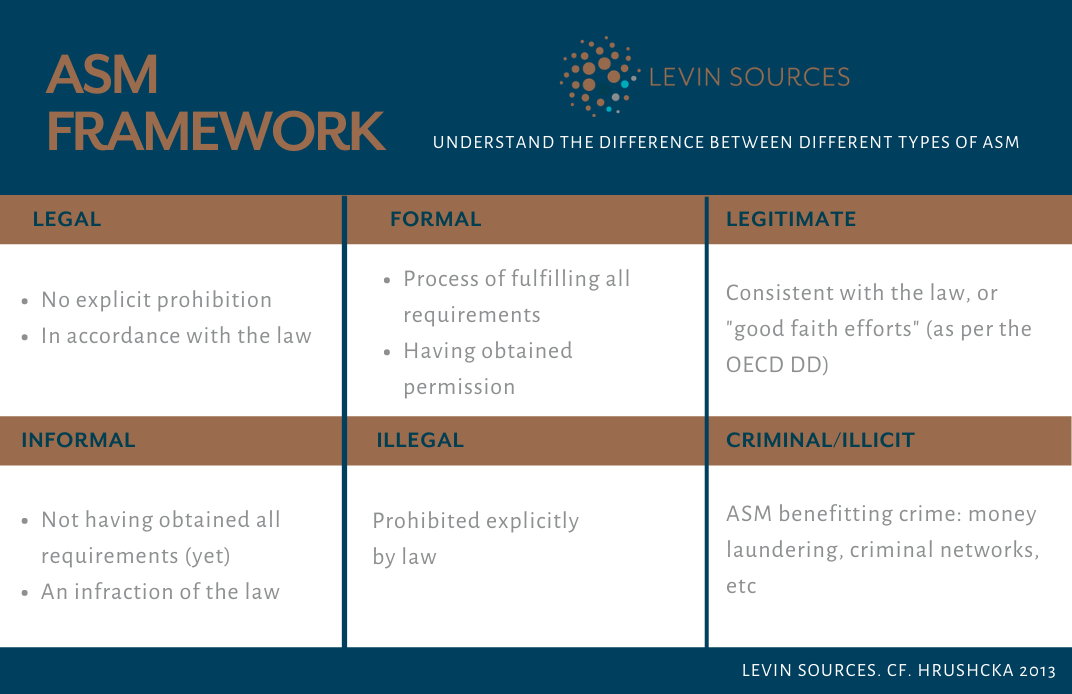The perception of ASM as comprehensively illegal understandably makes large-scale mining (LSM) companies reluctant to engage with the ASM on or near their concessions. Where the ‘illegal’ label is applied generally to ASM, sometimes even used as a synonym for any ASM, engagement of ASM by LSM may be difficult from the outset. LSM also commonly believes that government authorities are uniquely or primarily responsible for engaging with ASM and ‘solving the ASM issue’. At the same time, the presence of ASM on or off an LSM concession may pose inherent risks to LSM companies, and to manage such risks, getting the mode of engagement with ASM right is crucial.
So when is it ‘okay’ to engage with ASM and when is it a no-go? We provide a guidance to differentiate types of ASM and what appropriate engagement measures could be.
ASM is not consistently illegal
ASM is not consistently illegal and a much more nuanced view is needed.
On a general level, many legal frameworks do not just distinguish between two categories, legal and illegal, but include various stages of infractions of the law and differentiate corrective measures or punishments connected to these. A single or even multiple infractions of the law do not make the whole activity or business illegal; a legal business may commit an infraction of the law, or may violate a regulation.
Illegal only designates what is explicitly forbidden in the law, as Felix Hruschka pointed out in an earlier blog. ASM may be explicitly prohibited in certain areas, for example in an LSM concession, a natural park, urban area or border zone. When ASM takes place in these explicitly prohibited areas, then, yes, the ASM is illegal. However, if ASM operates in areas where it is not explicitly forbidden (i.e. outside of LSM concessions, protected areas, border zones, or urban areas, etc.), the activity is not necessarily illegal, even though some specific actions connected to it may be an infraction of the law, for example not having a permit, or not completing an environmental assessment. In such cases, the term informal ASM is used.

To give an example: If an ASM individual or organisation operates in an LSM concession with exclusive mineral rights, the ASM is illegal. If ASM operates outside the concession area, where it is not forbidden, but does not have a permit, it is not illegal but informal. It may also help to think of the example of a supplier or contractor to an LSM mine: A supplier may be fined because their workers were not compensated for overtime and the company was in breach of the labour law. This does not automatically make the supplier illegal. The infraction of the law is punished and expected to be corrected.
Besides the nuances between illegal and informal, the terms ‘criminal’ and ‘illicit’ are also often used interchangeably in connection with ASM. These are sometimes used to brand ASM as a whole, but they designate specific activities by specific actors that seek to benefit from ASM or the connected trade of minerals, with the purpose of financing criminal activities (i.e. illegal, explicitly forbidden activities) such as financing of armed conflict, drug dealing, money laundering, etc.
But with all those nuances, what type of ASM should LSM engage with?
Differentiating between these categories of formality is a crucial first step in understanding which types of ASM LSM companies can and should engage with, and thus what the modes of engagement could be. Building on this, a useful good practice guide has been developed in the sphere of responsible sourcing, which can be applied by LSM companies as well: The OECD outlines the concept of ‘legitimate ASM’ to guide downstream companies in their decisions on whether or not to buy minerals mined by ASM, as part of their broader OECD Due Diligence Guidance for Responsible Supply Chains of Minerals from Conflict-Affected and High-Risk Areas (OECD DDG). Legitimate ASM is defined as either being consistent with applicable laws, or, in the absence of a legal framework or if the legal framework is not enforced, as being able to show evidence of ‘good faith efforts’ to work within the legal framework (i.e. obtaining permits) and pursue formalisation. Formalisation is a process of gradual acquisition of permits, compliance with regulations, payment of taxes etc. to become as legal as possible.
If ASM is making this effort, and is not contributing to serious abuses or conflict, then the OECD DDG recommends that companies work together with governments and engage with these ASM. It also encourages companies to support ASM in improving their operations and becoming fully formalised and legal, rather than disengaging or not engaging with ASM at all. The guidance recognises that this is a process that takes time and that companies cannot do it alone, collaboration with governments and other actors is crucial.
This means that LSM companies should not only engage with an ASM individual or entity that has a permit and is fully formalised, but may also engage with ASM that can be considered ‘legitimate’, i.e. is making credible efforts to become formal and legal. Consequently, LSM companies need to understand what types of ASM are happening on or around their concessions, and where they fit on the spectrum of formality. In cases where an ASM miner is not illegal but does not have a permit, the LSM company should find out why, before making a decision on whether or not to engage:
- If the ASM actors show no interest in obtaining a permit or make use of their informal status to finance criminal activity or to commit serious abuses, companies should not engage.
- If ASM actors are interested in obtaining the necessary permits and can show evidence that they are trying, but are slowed in their efforts by a complicated permit regime or a process that is difficult or infeasible for ASM, companies should collaborate with the government to engage with these ASM actors, and – where possible and feasible – support their process towards a formalised, improved operation.
Effective risk management requires a differentiated view
In order to effectively manage the risks inherent in LSM-ASM relationships, LSM companies need to engage with ASM. But proactive and effective engagement is only possible if LSM companies cease to equate ASM with illegality wholesale and start to take a nuanced view of different types of ASM. Good practice guidance on this already exists, and in our next blog we will further explore what industry standards say about good practices in LSM-ASM relationships.



